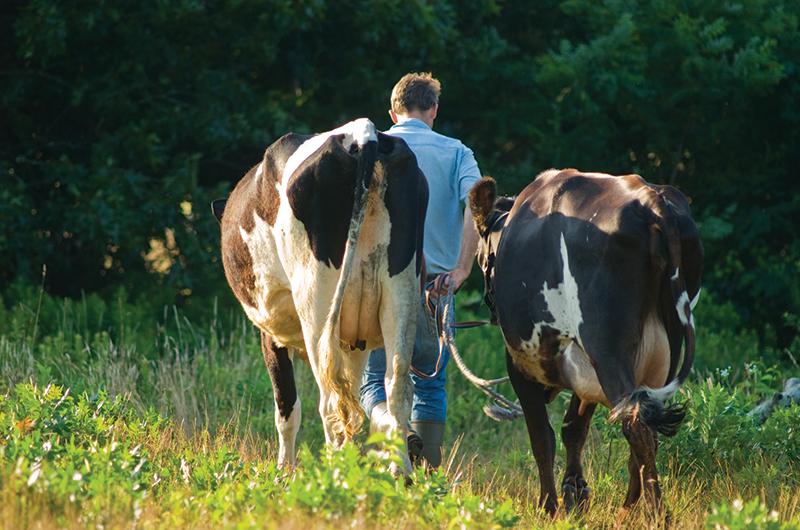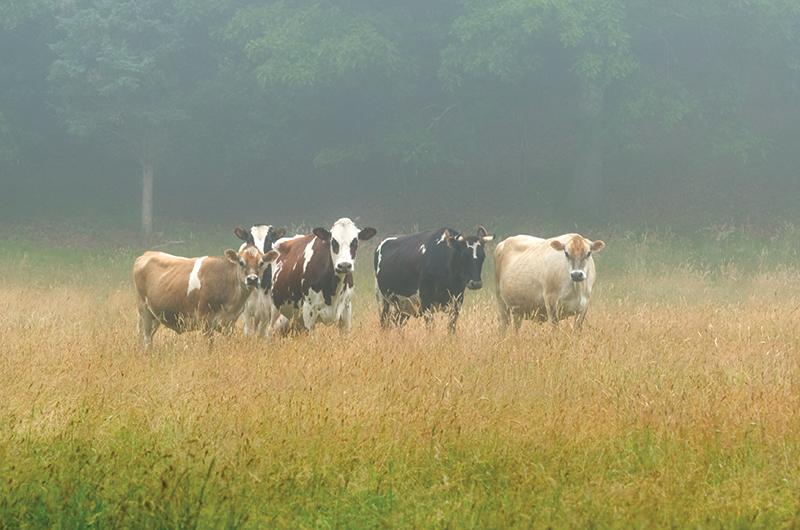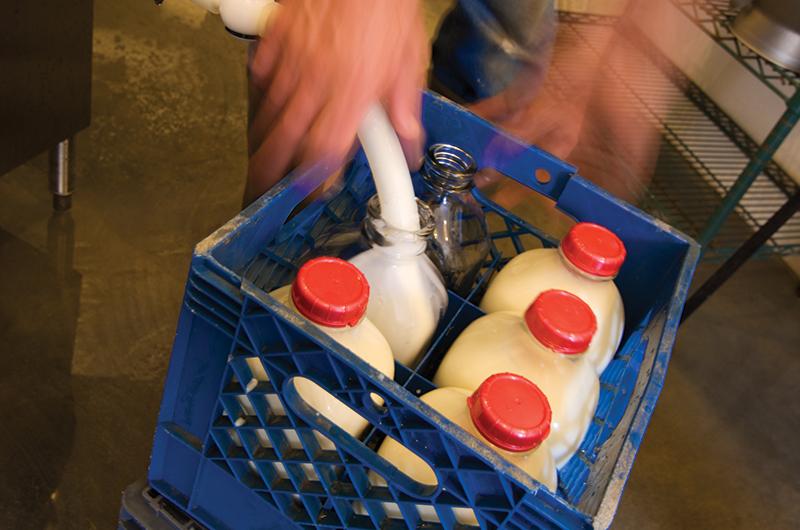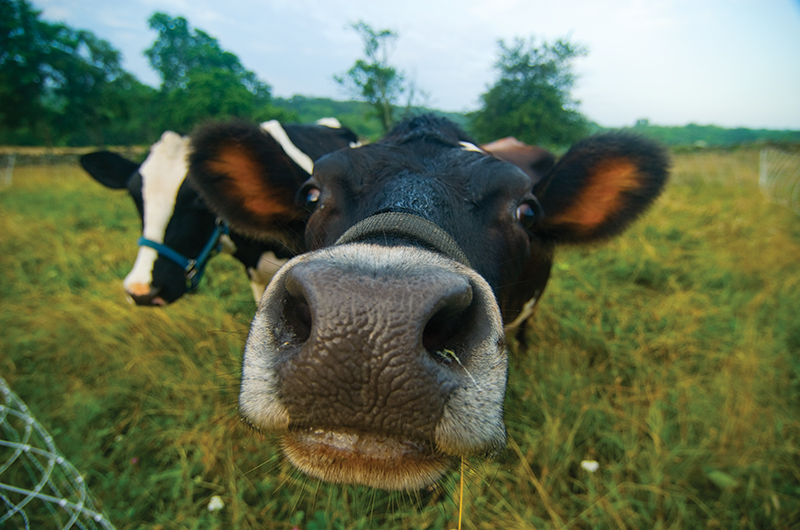It’s 5:30 a.m. on a Sunday morning and Allen Healy walks down the worn path from his house to the barn. It’s a warm summer day, and he gets right to work. He sanitizes two milk buckets as well as the equipment to milk his cows.
He heads out to the pasture and leads in Raspberry first, a Jersey-Ayrshire cross born in January of 2005 on the farm in Chilmark. She’s a sensitive cow that needs lots of handling, and after placing her in the hold for milking, he temporarily secures a small chain around her two hind legs to keep from getting kicked. Raspberry wasn’t the easiest cow to begin his dairy career with – comparatively, Clarissa, the Holstein he brings in next, is “an easy milker.” They both begin munching the grain waiting for them as he continues preparations.
With these two cows, Allen can produce about twelve to thirteen gallons of milk a day, which he sells straight from the cow (unpasteurized and unprocessed) to preserve nutrients. He’s been increasing production of late, as he now has a herd of eight dairy cows on Mermaid Farm’s thirty-six acres, which he operates with his wife, Caitlin Jones.

The dairy heyday on-Island was in the 1950s when dozens of dairies produced more than 750,000 quarts annually to supply the Island as well as export to Nantucket. Although a modest operation, Mermaid Farm currently has the distinction of being the only dairy on the Island. To purchase Allen’s farm-fresh yogurt and milk, which many say they love for its taste and freshness, people drive from every Vineyard town. His loyal customers, who now number about seventy-five, include a mortgage lender, an art gallery owner, chefs, other farmers, and many families with children.
Like a first-time parent with a newborn, Allen, thirty-eight, has had to learn about dairying on the job. Allen’s family moved to West Tisbury when he was in his teens and he worked at the Allen Sheep Farm in Chilmark in his early twenties. He has training in airplane mechanics and has worked in landscaping. He starting raising sheep about a decade ago (and currently has seventy), before he got into dairy farming.
“I have contacts I can call when I have a problem I just don’t know the answers to,” he says about raising and milking the cows. The first week he started milking, he received some on-the-site guidance from former dairy owner Fred Fisher Jr., who came over during the evening milking. Fred owns Nip ’n Tuck Farm in West Tisbury and sold bottled raw milk until a few years ago when he lost his grandfathered right to sell it after stopping the operation temporarily.
Located across from Brookside Farm on Middle Road, you enter Mermaid Farm through a small driveway and see a self-serve stand where Caitlin sells plants, strawberries, heirloom tomatoes, and whatever’s ripe that day. (She specializes in heirloom tomatoes; this past summer, she planted more than four hundred tomato plants.) As you head up the driveway toward the barn where the milk is kept, you pass grassy fields encased in fencing, mounds of compost, a few greenhouses filled with tomato plants, and several gardens. The milk production area inside the barn is a contrast to the verdant farm outside. It’s filled with stainless steel sinks and racks to hold the equipment, and a large, new, stainless bulk tank for holding and chilling the milk. The tiled floor has a drain in the middle to make the room easy to hose down on a daily basis.

The dairy operation is certified by the state, and Allen had to learn about state regulations. He was also required to take a state-mandated food safety course and pass an exam. A milk sample is tested for coliform (bacteria) and white blood counts (for any disease) every month at a lab off-Island.
In addition to reading a lot of books on the subject, Allen also works closely with the state dairy inspector who visits once a month. Allen says the inspector is a knowledgeable, smart guy with good suggestions. The inspections are intended to be surprise checks, but Island logistics get in the way, says Allen. “I have to pick him up at the boat. I’m the only dairy he can’t sneak up on.”
Allen walks through the ninety- minute milking routine with ease. First, he washes and sanitizes the claws – each has four inflations or tubes that fit over the cow’s teats to draw the milk. After bringing the cows in, he cleans the udders with an iodine solution to prevent any cross contamination before attaching the claws. The milk is pumped into stainless buckets, and then Allen immediately pours it in the holding tank, which cools the milk down and keeps it cold. By the time Allen finishes all the milking, the temperature of the milk is 35 degrees. The morning routine also includes washing and sanitizing the half-gallon milk bottles and filling them with cold milk, to be sold the same day.
The half-gallons of milk are stored in a cooler in the back of the barn and sold for $5 each (although Allen gives a 10 percent discount to anyone who walks or rides a bike to pick up the milk). The milk is left whole with a layer of cream on top, which some people siphon off to use as cream or make into butter. Many note the milk tastes luscious and creamy, without the chemical aftertaste of store-bought milk. Customers can pick up milk anytime, dropping their money into the black-and-yellow Chock Full o’ Nuts coffee can, and in the summer when demand is high, regulars can choose specific days to pick up bottles, marked with their names. Back in March, neither cow was producing milk, so customers had to revert to supermarket milk temporarily.
With milking finished, the room is hosed down, the cows led back into the pasture, and the calves watered and fed. Allen grabs a stainless steel milk bottle for his family’s consumption, before heading back home, where his next job awaits him: feeding his sons Kent, three and a half, and Everett, six, and getting them ready for the day – or school depending on the time of the year.
Allen met Caitlin fourteen years ago and they married five years ago. The farm was in Caitlin’s family, who bought sixty acres from Brookside Farm in 1968. Most of the land has been put under conservation restrictions, and Caitlin and Allen co-own the thirteen acres in front with Caitlin’s brother, Douglas, and their parents, Virginia and Everett Jones.
After milking, Allen’s days are filled with a variety of jobs: fixing fences, breeding cows, moving cows or sheep, haying, tractor work for Caitlin, fixing tractors, among others. At 5 p.m. he’s back to milking the cows, following the same routine as the morning.
“It’s a challenge,” he says, but he likes it. He also likes growing grass, haying, and tractors – and working for himself.
Allen says he should be in bed by 8:30 to 9 to get up at 4:45 a.m. seven days a week (he slept in the day of this interview, getting up at 5:30), but he rarely gets to bed before 10, and then is often awakened by one of the kids during the night. Two nights ago, he had four hours sleep and says, “I was a zombie yesterday. Our youngest doesn’t sleep very well. Having kids and doing this is really hard.”
He has two other youngsters at the moment – two calves. Dairying requires cows that give birth on a regular basis; after giving birth, a cow will produce milk for about ten months. Allen separates the calves from their mothers in the first week, but gives them a portion of the milk he secures each day. How did he learn to care for the calves? “Reading,” he replies.
A few years back, Allen hoped to start making cheese, specializing in sheep’s milk cheeses. But now he doesn’t think he’d have time. Instead, he started making yogurt from his milk, to the delight of his customers.
The intended cheese-making room has become the yogurt room, now outfitted with a stainless steel pasteurizer and a brand new machine that fills the containers with yogurt and secures the lids in place. He pasteurizes the milk – to kill off any bad bacteria and make room for the good bacteria yogurt is known for. He then adds a culture and incubates it for six hours at a temperature between 102 and 108 degrees. This gives the culture a chance to build up. Ideally, he’d like to make yogurt twice a week and produce 600 to 800 quarts. Recent efforts to seal the yogurt containers professionally and develop that end of the business should help him get there.
In addition to increasing his herd, he plans to build a portable milk parlor. This would allow him the flexibility to go to the cows where they graze in various fields, rather than bringing them into the barn for milking twice a day – which can be especially taxing if the cows are in a pasture down nearby Music Street. As far as he knows, it would be the first portable milk parlor in the state. The state inspector supports the idea, and Allen says each time the inspector visits the Island, they brainstorm on the prototype.
The portable system would not only allow his cows to remain pastured, but reduce their consumption of grain. Like other expenses that have increased with rising gasoline prices, the cost of organic grain has doubled, he says. “I want to get away from grain.”
So far, with the cost of equipment and getting his operation going, the farm has not made money on the dairy, nor does it make money on raising the sheep and selling lamb. (Frozen lamb cuts are available from a freezer on the farm and sold each Saturday at the West Tisbury Farmer’s Market.) “I just can’t charge enough,” he explains about selling lamb. “I tried to get bigger, everything just scaled up. Maybe you have to have a thousand sheep.”
Meanwhile, the family saves money by eating quite a bit off their land. They eat the lamb, milk, eggs, and chickens as well as strawberries, blueberries, and vegetables from Caitlin’s gardens. She freezes some vegetables for the winter, stores others in a root cellar. Caitlin does some canning and preserving, though not as much as she did before kids. “We don’t spend any money on ourselves,” Allen says.
Even in the days when dairies proliferated the Island, most farmers could not support their families through the sale of milk, cream, and vegetables alone. To help make ends meet, Allen currently works as the assistant animal control officer for Chilmark.
“I think there’s more room for dairies on the Island,” says Caitlin. “But it’s a labor of love. We didn’t grow up with dairying. We’ve had to learn the hard way and it’s been hard.”

Raw milk
While Allen Healy’s day-to-day routine keeps him focused on his farm and his family, the raw milk he sells is in the spotlight. Demand for raw milk – which is unpasteurized and unprocessed – has grown along with the number of small family farms supplying it in Massachusetts, in New England, and across the country.
Currently, twenty-four farms are certified by the Massachusetts Department of Agricultural Resources to sell raw, unpasteurized milk. “That’s at least doubled in the past couple years,” says Kate Rossiter, coordinator of the Massachusetts arm of the Northeast Organic Farming Association’s (NOFA/Mass) Raw Milk Program.
People are specifically seeking out raw milk, as evidenced by several Mermaid Farm customers, including Cindy Fitzgerald, a mother of three grown children, who lives in West Tisbury. A recent Boston Globe magazine article on raw milk said people are driving miles and miles to make their purchases.
Cindy started drinking raw milk (she calls it “real milk”) and eating grass-fed beef as part of an effort to change her diet on the recommendation of a chiropractor. “My health is greatly improved,” she says. “I would like to get the word out about how important organic raw milk is, especially for growing children.”
“I’m really big on unpasteurized milk, so we were really excited” to meet Allen at the Farmer’s Market, says Brian Ward, who lives with his two children and his wife, Noelle Ruane, in Virginia – one of twenty-four states in the country that does not allow the sale of raw milk. But he says his kids drink it all summer while they are on the Island at Noelle’s parents’ house in Chilmark. “They love it.”
Why are people seeking out raw milk? Proponents say pasteurization, which kills off potentially harmful bacteria in the milk, also eliminates many of the nutrients. According to the NOFA/Mass Organic Food Guide, pasteurization almost entirely destroys vitamins B6 and B12 and reduces vitamins A, D, E, and F by up to 66 percent, with a vitamin C loss of more than 50 percent.
Three key enzymes in milk are diminished or destroyed by pasteurization: lactase, which aids digestion of lactose; lipase, which helps digest fats; and phosphatase, essential for the absorption of calcium. Some people may be concerned that it’s necessary to drink milk fortified with vitamin D to help absorb calcium, but in addition to the phosphatase in raw milk, the NOFA/Mass guide indicates the dairy fat in raw milk “is necessary for the absorption of milk’s calcium and protein.”
“More people are drinking it more faithfully,” says NOFA/Mass’s Kate Rossiter. “More people are talking about the health benefits.” As more people consume raw milk, the “less people are afraid of it.” Other factors contributing to the increased consumption is the whole local food movement, says Kate, and the fact that small farms are interested in selling raw milk themselves because it commands a higher price than regular milk, and they can make more money selling it directly from the farm than they can shipping milk to larger companies.
Only a few states, including Connecticut and California, allow retail sales of raw milk. Others, like Massachusetts, allow farm sales only. The sale of raw milk remains controversial among some dairy farmers and regulators, who highlight the health risk of bacteria such as salmonella, listeria, and E. coli in contaminated raw milk that could infect drinkers, causing illness. Kate suggests that people seek out a farm that is certified by the state, and if they are not, to check if the farm gets its raw milk regularly tested for coliform and bacteria levels.
“I honestly don’t worry about it,” says Kara Merry of West Tisbury about buying raw milk from Mermaid Farm and giving it to her two daughters. “They know what they’re doing,” she says about the farm. “It’s clean and they’re educated about it.”
In fact, Kara says, her whole family loves it. “Matt [her husband] and his father will sit down at the table with a gallon of milk. It’s in their family.” Matt’s great-grandfather Lloyd Merry and grandfather Joseph Merry had a dairy farm in West Tisbury, she explains.
“I feel like I’m doing something so good for the family, nothing’s being taken out,” Kara adds. “I think it’s great for the community,” though she adds, it’s a lot of work for the dairy farmer.
The history of dairies on Martha’s Vineyard
From 1900 to 1950, more than 50 percent of the land on Martha’s Vineyard was farmland, supplying the Island community with much of its milk, cream, eggs, and some meat, according to the “History of Dairy Farming on Martha’s Vineyard,” an article written by Clyde MacKenzie Jr. for the Dukes County Intelligencer in 1997.
In the early farming days, dating back to the mid-1700s through the 1800s, pastures on the Island were devoted to sheep raising. In the late 1800s, low prices for wool forced most of the sheep owners out of business. Around the same time, in the early 1900s, demand for fresh milk increased and many of the farmers turned to dairy farming and became commercial milk producers.
In those decades from 1900 to 1950, there were up to a dozen dairy farms in each town on the Island, including Chappaquiddick. One of the first dairies was Seven Gates Farm in North Tisbury, started by Nathaniel Shaler. At its height around 1910, the two-thousand acre dairy had sixty milking cows and employed twenty farmhands. Among many other dairies operating in the first half of the century were Flat Point Farm in West Tisbury, the Roland Luce Farm in Oak Bluffs, and Manuel Bettencourt’s farm on Clevelandtown Road in Edgartown. Katama Farm, also in Edgartown, was on the tail end of that boom, switching from sheep to dairy farming in the 1940s under the ownership of Elisha Smith.
The Island even had a Cooperative Dairy, established in 1946, composed of many of the dairy farmers. The cooperative grew to more than thirty farms in 1954, producing more than 750,000 quarts annually. Milk from participating farms was taken to the Dairyland Barn in Edgartown (in the area known as Cow Bay, near Bend in the Road,) where it was pasteurized and bottled, then delivered to homes – before this, milk had been sold “raw” from most of the farms.
But in the 1960s when farming in general declined, dairy farming – and the way milk was bought and sold – changed. Milk prices dropped, land prices increased, home delivery was eased out, and cardboard cartons of milk purchased from supermarkets became the norm. According to MacKenzie’s article, milk production by local dairies decreased by two-thirds. With the Island’s increasing popularity as a resort destination, many farmers sold their land, and milk production all but ceased. One farm, Nip ’n Tuck Farm in West Tisbury (operated by Fred Fisher and his son Fred Fisher Jr.) continued into the 1990s.
And today, only Allen Healy and Caitlin Jones of Mermaid Farm carry on this Vineyard tradition





